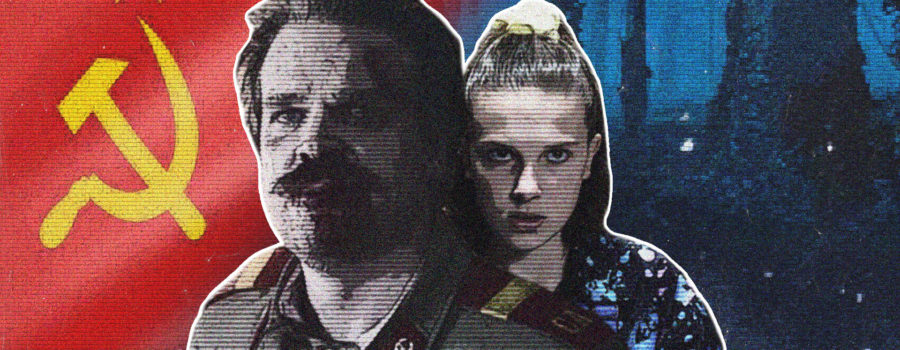[Published at Living Life Fearless] By now, Stranger Things fans across the world have seen the teaser for Season 4, titled, “From Russia with love…,”revealing Hopper’s fate. Although it may seem like a bold new direction for the series, The Duffer Brothers have interwoven a Cold War narrative into the fabric of Stranger Things’ narrative since Episode 1. By the 1980s, the roaring threat of nuclear war, once lingering over the world during the Cuban Missile Crisis, had come to a dull murmur. However, Cold War hysteria still loomed large over American suburbs; despite the détente-focused Strategic Arms Reduction Treaty (START), Ronald Reagan initiated the Strategic Defense Initiative (SDI) in March of 1983. As outrageous as Donald Trump’s Space Force, SDI involved space, lasers, too many satellites, and an anti-ballistic missile system, no doubt adding to the aforementioned hysteria during the 1980s before the end of the Cold War.
Stranger Things begins in November of 1983, as Dr. Brenner, a high-ranking suit for the U.S. Department of Energy, is the director of Hawkins National Laboratory, using El, to communicate with Russians in order to gather intel, among other, Upside Down-y experiments. Dustin, references evil Russians in Season 1, Murray’s favorite conspiracies involve the Soviet government in Season 2, and there are actual evil Russians (caricatures of 1980s movie villains) in Season 3. On the surface, with an ensemble of children as its main characters, the series may appear to be geared toward a younger audience, but when examined with a fine tooth comb, Stranger Things proves to be a complex deconstruction of fact and façade between two opposing world hegemonies against the backdrop of the Cold War. Stranger Things’ depiction of Suburbia and its Upside Down parallel, represent America’s haunting consequences for every atrocity committed against itself and a foreign entity in the name of imperialism, for all of whom it has yet to indemnify.
Stranger Things proves to be a complex deconstruction of fact and façade between two opposing world hegemonies
The Duffer Brothers make a point to put Reagan signs in front of the Wheeler’s house in the nosy town of Hawkins; it is at once a pointed satire of 1980s suburban films, many of which are in and of themselves satires, and an allegory for the blood on Reagan’s suburban revival and hysteria-inducing Cold War strategy’s hands, détente be damned. Hawkins’ Suburbia is an extension of post-war economic expansion at the expense of both the havoc we wreak abroad, as well as the citizens we use as fodder and the families we break up as consequence, whose memories we cover up beneath the uniform housing developments that scream “we will blindly pave our manifest destiny onwards as individuals (in groupthink) pursuing the American Dream.” They consistently bury American trauma and foreign war crimes under the rug, and, over time, the untended pain, which the insidious to banal evil causes, festers.
The “American Dream”
Consider the Mind Flayer as the Upside Down’s conflicted “brain,” the Demogorgons and their lesser developed selves, the Demodogs, as the endless manifestations of its amoral will, the roots as its ever spreading body and limbs; it is America’s conscience. When it attached itself to Will, it didn’t succeed in willing him to fulfill its agenda, but subsequently left him with severe PTSD, not unlike what America does to its own soldiers and those of its enemies and its enemies citizens with reckless abandon alike. The Upside Down chooses Billy because, like it, he is amoral – he is a sociopath — America personified; it feels this. It senses that the disjointed, diseased mind and body of Billy, at war with each other, makes for the perfect warrior to lead its senseless cause. Like a person’s conscience, it is not sentient. It sits in the back of one’s mind. It lingers beneath the ground of Hawkins. In El’s body. In the back of Will’s neck. In Billy’s corrupted mind. In the mindless Flayed. The Upside Down, America’s bloody conscience, fails, once again, to infest our world — to shatter our reality — through Billy, because it fails to realize that Billy has a shred of humanity left in him. Billy’s angst, boredom, and chaotic suburban anchorage, like the Upside Down, metastasizes. It infects unassuming citizens like the Flayed — the brainwashed citizens unconsciously manipulated by the negligence of the government. Like the suburban lifestyle, it brainwashes them to participate in the capitalist lifestyle. To do America’s bidding at home and abroad. To risk their bodies and the flesh of their loved ones for the conceit of freedom in the face of insatiable greed and damaged ego.
Billy’s angst, boredom, and chaotic suburban anchorage, like the Upside Down, metastasizes
As aforementioned, like many ‘80s TV shows and films, the Cold War is as much of a lurking entity behind Hawkins as the Upside Down is. More than 30 years after the collapse of the Berlin Wall, the Cold War commentary in Stranger Things takes a more self-aware, neutral perspective on the conflict. Vera Lynn’s “We’ll Meet Again” plays during a Cronenberg-esque sequence, during which the Mind Flayer gathers the mindless, brainwashed, acquiescent Flayed Hawkins citizens, lined up in concert. It may seem like a catchy tune to throw in with this montage, but it is not random. “We’ll Meet Again” was made famous during World War II, when soldiers and families alike would listen to it while they were separated by military obligation. After the war, when America recovered with haste while Europe lay war-torn, during the Cold War, the song was included on the roster of 20 radio stations of BBC‘s Wartime Broadcasting Service‘s (WTBC) cautionary program of 100 days of information and comfort after a potential nuclear attack, and reached 29 as its position on Billboard’s Hot 100 chart; tension tightened as decades passed.
Fortunately, the WTBC never had to enact its 100 days program. As the Cold War grew more symbolic and detached from the violent, emotional confines of war, “We’ll Meet Again” lost its meaning. America began to fight wars and engage in conflicts that didn’t align with the values of its citizens, and the song took on an even more tragic meaning as we slaughtered our people and our neighbors abroad, through public wars and covert Pentagon genocidal crusades, in the name of greed, power, manipulation, and maintaining hegemony – we overtly became the imperialist threats we had been fighting throughout our history; a paradoxical paradigm shift. We reared the ugly head that nearly killed off the Native American race. The head that enslaved and subjugated Black people for centuries. The head that refused to intervene in World War II until 1941 because it considered its economy more precious than upwards of 20 million innocent lives. The head that aimlessly bombed Hiroshima and Nagasaki, annihilating more than 200,000 civilians. The head that orders drone strikes on inhabited land like a child gleefully playing a fucked up video game. The same head that funded $800 million to more than 35,000 Afghan rebels from 1979 to 1988 in order to train them against a communist forces, creating the foundation for the Taliban and Al-Qaeda — jihadists Jalaluddin Haqqani and Gulbuddin Hekmatyar — members of Osama bin Laden’s close-knit circle, were two of the largest beneficiaries of the Pentagon’s funding. The head that happily elects foreign dictators prone to genocide for the sake of the expansion of its cultural hegemony. The head that murders human beings who have a different political ideology than it. The same hypocritical head that actively tries to keep its citizens asleep throughout the neighborhoods among its diseased thalamus and cortex.See also
This friction created by the clash of our own values — imploded upon themselves — is the essence of the Upside Down in Stranger Things. The Flayed, mostly women, elders, young children, and incapable, the people who would likely stay home from war and mourn the fallen soldiers during wartime, are the sterilized, emasculated Suburban creations, seemingly entranced behind the Mind Flayer’s chosen leader, Billy — the violent, alpha byproduct of America’s unjust wars and crimes against humanity. Meanwhile, the outcasts, the oddballs, the teenagers, conspiracy theorists, the damaged, see through the daydream — the conceit that our government serves us with our best interest in mind. These characters in Stranger Things are the ones who prevail, who fight against the ungodly forces that America has created with its blood-thirsty, power hungry ideologies.
The outcasts, the oddballs, the teenagers, conspiracy theorists, the damaged, see through the daydream
The Space Race, Nuclear Arms Race, the Dick Measuring Race all boils down to which world power’s cultural hegemony can prevail. Capitalism still rules the world, so America perceives communism as a threat to its existence. In the 1980s, as evidenced by Reagan’s SDI program the arms race was heading outside the proverbial box. The Duffer Brothers take that concept to a science fiction extreme. However, the competition depicted between America and the USSR remains considerably accurate; when we developed a new weapon, it was imperative for the Soviets to scramble to outdo us, and vice versa. There was an urgency, largely unwarranted, created, in part, by decades of opposing economic values clashing. Alas, when the kind folks at the Hawkins National Laboratory tapped into the weaponized potential of the Upside Down, so, too, did the Soviet Union. In fact, one could argue that the portal that El opened, and, subsequently closed, leads directly to the location seen at the end of Season 3 and in the teaser trailer for Season 4, which may explain how Hopper ended up 5,400 miles from home. So, both the Americans and the Soviets have Demogorgons, but will this manifestation of America’s collateral damage pick a side? Does a victor rise out of a nuclear war? According to America’s Cold War strategy of Mutually Assured Destruction (MAD), in which both sides of a conflict would be annihilated during a conflict, first declared during the 1960s, no. Nobody wins. The world loses.
As such, Season 4 of Stranger Things’ world will expand, for obvious reasons, beyond Hawkins. However, it will also expand, thematically. It isn’t our favorite Hawkins residents against a shady American government or evil Russians, it’s all of the above against the Upside Down. It’s humanity against nuclear destruction. Against the beast that America, the most virulently destructive nation in the history of the world, has created.








Leave a Reply
Your email is safe with us.